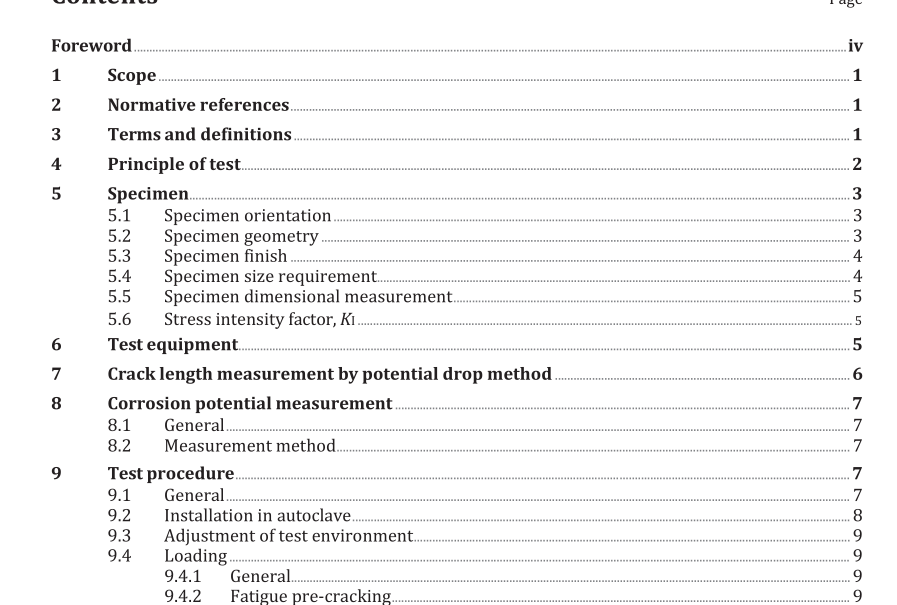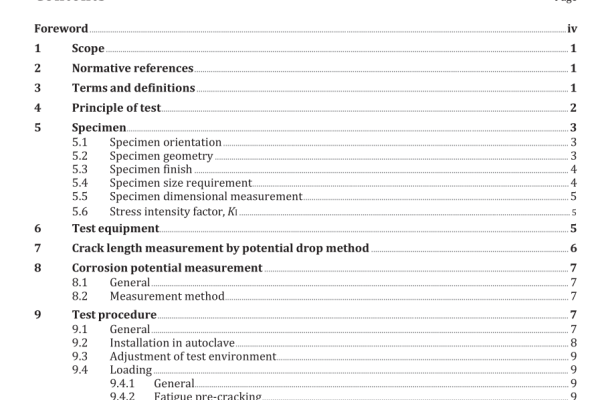ISO 22848:2021 pdf download – Corrosion of metals and alloys — Test method for measuring the stress corrosion crack growth rate of steels and alloys under static-load conditions in high-temperature water.
1 Scope This document specifies a test method for determining the stress corrosion crack (SCC) growth rate of steels and alloys under static-load conditions in high-temperature water, such as the simulated water environment of light water reactors. The crack length of the specimen is monitored by a potential drop method (PDM) during the test in an autoclave. The test method is applicable to stainless steels, nickel base alloys, low alloy steels, carbon steels and other alloys. 2 Normative references The following documents are referred to in the text in such a way that some or all of their content constitutes requirements of this document. For dated references, only the edition cited applies. For undated references, the latest edition of the referenced document (including any amendments) applies. ISO 7539-6, Corrosion of metals and alloys — Stress corrosion testing — Part 6: Preparation and use of precracked specimens for tests under constant load or constant displacement 3 Terms and definitions For the purposes of this document, the terms and definitions given in ISO 7539-6 and the following apply. ISO and IEC maintain terminological databases for use in standardization at the following addresses: — ISO Online browsing platform: available at https://www.iso .org/obp — IEC Electropedia: available at http://www.electropedia .org/ 3.1 potential drop method PDM non-destructive method for measuring a crack length based on the change in the electric potential as a crack propagates in the presence of an applied DC or AC current 3.2 stress corrosion crack transitioning SCC transitioning use of cyclic loading at low frequency and with increasing hold time at maximum load in the test environment to promote a transition in the fracture surface morphology from a transgranular (TG) fatigue pre-crack to SCC, typically intergranular (IG) or interdendritic (ID) morphology for austenitic alloys 3.3 crack-tip re-activation loading use of loading cycles to re-activate the tip of crack when crack retardation is observed under a static loading
3.7 crack engagement specimen thickness B where the stress corrosion crack has advanced Note 1 to entry: It is expressed as a percentage. 3.8 average crack extension A 1 average crack extension across the specimen thickness using a crack growth area or many equally spaced measurements of crack length (equally divided method) 3.9 average crack extension in crack engagement area A 2 average crack extension based on the fraction of the specimen thickness where the stress corrosion crack has occurred 3.10 minimum crack extension A min minimum extension of the stress corrosion crack in the specimen 3.11 maximum crack extension A max maximum extension of the stress corrosion crack in the specimen 4 Principle of test Stress corrosion cracking is a phenomenon in which a crack grows in an environment when stress is applied to a susceptible material. Thus, stress corrosion cracking is affected by three general factors: the material, stress and environment. The SCC growth rate is affected by the stress intensity factor, K I . The SCC growth rate, da/dt , is defined as the time derivative of the crack length.
ISO 22848:2021 pdf download – Corrosion of metals and alloys — Test method for measuring the stress corrosion crack growth rate of steels and alloys under static-load conditions in high-temperature water






